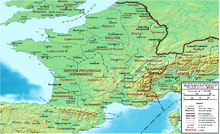Dux Germaniae primae

The Dux Germaniae primae (literally: "Heerführer der Germania I") was a high officer in the late antique army of the Western Roman Empire and commander in chief of the limit units stationed in the province of Germania prima .
The command area of the Dux most likely included the Rhine border between Seltz and Andernach . He was under the Magister peditum (commander in chief of the infantry) and the Magister equitum (commander in chief of the cavalry). At the imperial court, a Dux limitis - since Valentinian I - belonged to the second senatorial class of viri spectabiles .
Well-known Duces:
- Arator (since 368)
- Hermogenes (between 369 and 372)
- Florentius (between 369 and 372)
function
The Dux had only the military protection of the boundary portion in the Germania I to worry. He was not entitled to supervise the civil administration - despite his higher rank than the Consularis Germaniae primae . Only the Limitanei / Riparienses permanently stationed in his area of responsibility and possibly existing naval units are subordinate to him, but not the Comitatenses temporarily located in his sector .
development
In the course of the imperial reform of Diocletian , two new provinces emerged from the Germania superior around 297, Germania I and Maxima Sequanorum . Since the military agendas had been strictly separated from the civil agendas, the border troops stationed there were subordinated to two duces , the Dux Germaniae primae and the Dux provinciae Sequanicae , as is customary elsewhere . The former probably had its headquarters in the provincial capital Mogontiacum / Mainz. The Germania prima was divided 394-423 in two military districts: in the Comes tract Argentoratensis (HQ Argentorate / Strasbourg) and the Dux Mogontiacensis (HQ Mogontiacum ). The office is only known from the western Notitia Dignitatum . It appears there in the List of Dux Limites , Chapter I and again in the heading of Chapter XXXIX. In the absence of other contemporary sources, it is extremely difficult to trace its history and is largely pure speculation.
- In the early 19th century, Johann Ernst Christian Schmidt took the view that the Dux of Germania I was identical to the Dux Mogontiacensis . He suspected that the place name of the latter was originally set by the authors only as a marginal note - for geographical orientation - and then the copyists were the only ones to be included in the medieval copy.
- Denis van Berchem is of the opinion that the Mainz ducat, after the overthrow of the usurper Eugenius , was established in the course of an inspection trip by the western army master Stilicho towards the end of the 4th century. The Comes, together with the Dux, took over the defense of the section of the Dux of Germania I, either deposed or no longer able to act .
- According to Ralf Scharf, it would also be possible that the Dux Germaniae primae listed in Chapter I of the Notitia was actually the commander of Germania secunda (Lower Rhine). The military leader of this not insignificant section of the border is nowhere mentioned in the Notitia Dignitatum Occidentalis . The missing list of troops in Chapter XXXIX was either not completed in time in late antiquity or was not taken into account by the medieval copyists for unknown reasons.
Troops and administrative staff
The list of troops and the composition of his administrative staff have not come down to us in Western Notitia or other ancient sources. Presumably they coincided largely with those of the Dux Mogontiacensis .
See also
List of forts in the Danube-Iller-Rhein-Limes
literature
- Ralf Scharf: The Dux Mogontiacensis and the Notitia Dignitatum. A study of late antique border defense . Walter de Gruyter, Berlin et al. 2005, ISBN 3-11-018835-X (= Reallexikon der Germanischen Altertumskunde supplementary volumes, Volume 48) ( limited preview in the Google book search).
- Jürgen Oldenstein : Alzey Castle. Archaeological investigations in the late Roman camp and studies on border defense in the Mainz ducat . 2009 ( PDF, 14.9 MB - Habilitation thesis University Mainz 1992).
- Michael S. DuBois: Auxillae: A Compendium of Non-Legionary Units of the Roman Empire. Lulu Press 2015, ISBN 978-1-329-63758-0 .


